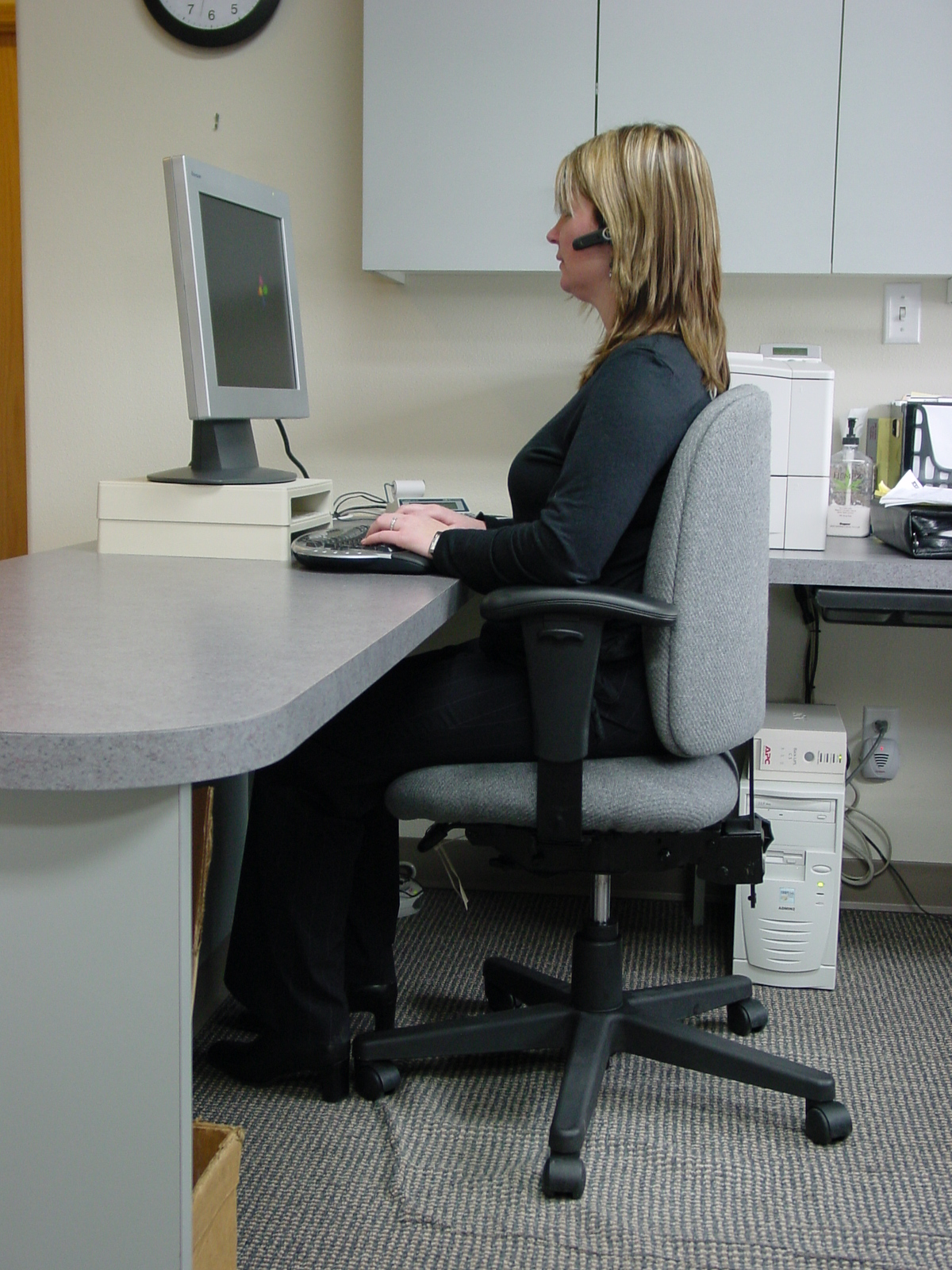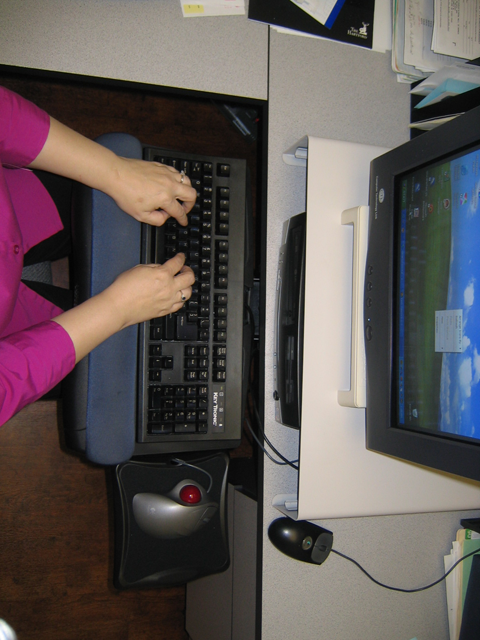How to optimize and "ergonomize" your front office
Ergonomic challenges in the front office rivals can often rival those in the dental operatory! Just as in many dental operatory scenarios, you don’t have to break the bank to ‘ergonomize’ your front office. Here are the top problems I encounter in dental front offices and easy, economical fixes.

Ergonomic challenges in the front office rivals can often rival those in the dental operatory! Just as in many dental operatory scenarios, you don’t have to break the bank to ‘ergonomize’ your front office. Here are the top problems I encounter in dental front offices and easy, economical fixes.
Phone shoulder holders
Fig. 1

Perhaps the most dangerous of all front office risk factors is holding the phone between one shoulder and ear. Why do so many front office people do this? Simple: because they don’t have three hands! Usually, the phone conversation requires utilizing the computer, which requires both hands. Invariably, this habit will eventually cause neck and shoulder pain on one side of the body. Wireless phone headsets should be considered mandatory for all front office workers who spend more than 25 percent of their time on the phone. This is an easy and comfortable solution that can be worn over one ear, and calls may be answered from afar in the office through a remote phone lifter device.
More from the author: Demystifying pain among women in dentistry
Monitor off-center
Due to an inherent need to see incoming patients, monitors are often placed to one side of the keyboard, causing the front office executive to work with the head turned to one side. Combine this with the ‘phone shoulder holder’ habit (Fig. 1) and you have a recipe for a musculoskeletal disaster. In this case, intervention is not an option, it is a must! Make sure monitors are always placed directly behind the keyboard. If space is a consideration, it may be time to upgrade to a flat-screen monitor.
Fig. 2

Monitor height
Working with the monitor too high or too low can result in neck pain. The top of the monitor screen (not the monitor) should be at or slightly below eye level. Have someone check this from the side, while sitting in a chair. Most frequently, I find the monitor is positioned too low. Risers may be placed under the monitor to raise the monitor to the proper working level. (Fig. 2)
Related reading: The 4 ergonomic 'must-haves' in a patient chair
Continue to page two to see more common mistakes...
Fig. 3

Office ‘thrones’
Although most front office executives are female, the majority of office chairs are designed for the average European man. Walk into any generic office store looking for office chairs and you will find many large, cushy office chairs, with tall backs, no lumbar support and reclining tilt features. These office ‘thrones’ that reflect authority are a vestige of years gone past, when important political figures required large thrones with high backs to reflect status. Unfortunately, most ergonomic considerations (if there ever were any) went out the window with this chair style. Two problems predominate this chair design: deep seat pans and no lumbar support.
You should be able to sit all the way back in your office chair and easily place three finger widths between the back of your knee and the seat. If you cannot, your seat pan may be too deep, causing you to perch on the edge of your seat. This will quickly fatigue low back muscles, and may lead to low back pain. The chair should also have an adjustable lumbar support that tilts forward and adjusts up and down so the most convex portion nestles in the low back curve. Unlike their dental colleagues in the operatories, the front office team should be able to maintain contact with the chair backrest a majority of the time. A lumbar support cushion (BQ Ergonomics) resolves both problems, by making the seat pan shorter and adding lumbar support. (Fig. 3)
More from the author: Why all exercise is not necessarily good exercise for dentists
Mouse reaching
Ideally, your mouse should be placed at the same level as the keyboard to eliminate excessive reaching or, worse, repeatedly reaching up and out to the mouse. This can lead to pain in the ‘mousing’ shoulder. Frequently these individuals will find the shoulder blade on the mousing shoulder has shifted upward when compared with the opposite side.
A simple solution to this is a ‘mouse bridge’, which can attach to many keyboard platforms and either slides underneath the platform, or attaches on the side. (Fig. 4)
Fig. 4

Desk or keyboard height
Unlike the dental patient chair, the height of the front office counter or desk is usually non-adjustable. Working with the keyboard positioned too high results in similar pain patterns seen among dentists who position their patients too high. Pain, tightness and trigger points develop in the upper trapezius (neck and shoulders). Make sure your keyboard height facilitates a position where the forearm is level or sloping slightly downward. The angle of the keyboard should facilitate a straight, or neutral, wrist posture when viewed from the side. Inclined keyboard trays attached under countertops and allow for a slight downward sloping of the keyboard, which frequently solves both keyboard height problems and wrist angle problems.
Continue to the next page to learn more...
Ergonomic footrest
Shorter front office team members may require a footrest in order to position the chair high enough to be in the proper working position.
More on ergonomics: Hand pain in the dental practice: When it's not carpal tunnel
Conclusion
This touches the tip of the iceberg when it comes to front office ergonomics. Other considerations include lighting, temperature, keyboard shape, noise, etc. However, the aforementioned modifications will be a good beginning on the road to front office wellness.
Ergonomic intervention costs for the front office are usually minimal compared to those required in the operatories. And when it comes to impressions, your front office personnel are a mirror reflection of your business. Dentists will quickly recognize the benefits reaped from ergonomizing their front offices for a happy, more profitable, and comfortable front office team.
For a list of some of the author’s favorite Front Office Products, (including hyperlinks to products), please e-mail her at info@posturedontics.com.
Oral Health Pavilion at HLTH 2024 Highlighted Links Between Dental and General Health
November 4th 2024At HLTH 2024, CareQuest, Colgate-Palmolive, Henry Schein, and PDS Health launched an Oral Health Pavilion to showcase how integrating oral and general health can improve patient outcomes and reduce costs.
Episode 31: Dentsply Sirona Implant Announcements
September 30th 2021DPR’s Editorial Director Noah Levine sat down with Gene Dorff, Dentsply Sirona’s group vice president of implants and Dr. Dan Butterman to review several big announcements the company made in the arena of implants during Dentsply Sirona World 2021 in Las Vegas.